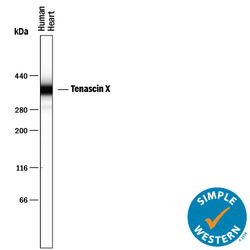Antibody data
- Antibody Data
- Antigen structure
- References [0]
- Comments [0]
- Validations
- Western blot [2]
Submit
Validation data
Reference
Comment
Report error
- Product number
- MAB6999 - Provider product page

- Provider
- R&D Systems
- Product name
- Human Tenascin X Antibody
- Antibody type
- Monoclonal
- Description
- Protein A or G purified from hybridoma culture supernatant. Detects human Tenascin XB2 in ELISAs and Western blots. Also detects Tenascin X in Western blots. In direct ELISAs, no cross-reactivity with recombinant human Tenascin R is observed.
- Reactivity
- Human
- Host
- Mouse
- Conjugate
- Unconjugated
- Antigen sequence
AAH33740- Isotype
- IgG
- Antibody clone number
- 766842
- Vial size
- 100 ug
- Concentration
- LYOPH
- Storage
- Use a manual defrost freezer and avoid repeated freeze-thaw cycles. 12 months from date of receipt, -20 to -70 °C as supplied. 1 month, 2 to 8 °C under sterile conditions after reconstitution. 6 months, -20 to -70 °C under sterile conditions after reconstitution.
No comments: Submit comment
Supportive validation
- Submitted by
- R&D Systems (provider)
- Main image

- Experimental details
- Detection of Human Tenascin X by Western Blot. Western blot shows lysates of human heart tissue. PVDF membrane was probed with 1 µg/mL of Mouse Anti-Human Tenascin X Monoclonal Antibody (Catalog # MAB6999) followed by HRP-conjugated Anti-Mouse IgG Secondary Antibody (Catalog # HAF007). A specific band was detected for Tenascin X at approximately 470 kDa (as indicated). This experiment was conducted under reducing conditions and using Immunoblot Buffer Group 8.
- Submitted by
- R&D Systems (provider)
- Main image

- Experimental details
- Detection of Human Tenascin X by Simple WesternTM. Simple Western lane view shows lysates of human heart tissue, loaded at 0.5 mg/mL. A specific band was detected for Tenascin X at approximately 376 kDa (as indicated) using 10 µg/mL of Mouse Anti-Human Tenascin X Monoclonal Antibody (Catalog # MAB6999). This experiment was conducted under reducing conditions and using the 66-440 kDa separation system.
 Explore
Explore Validate
Validate Learn
Learn Western blot
Western blot